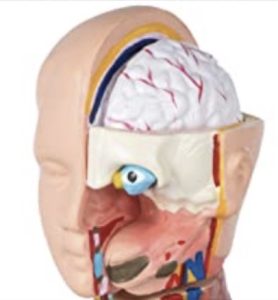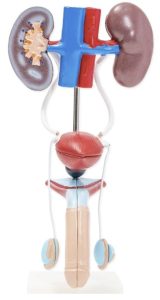The Human Body, Anatomical Terminology, Planes and Sections, Body Organization and Organ Systems
Objectives
- Introduce students to the study of the human body.
- Define and illustrate the anatomical position.
- Define directional terms and apply directional terms to descriptions of the human body.
- Define and describe anatomical planes by section.
- Locate and describe the divisions of major human and the serous membrane covering them.
- Identify the organ systems of the human body, their functions, components, and interactions.
Levels of Organization
The human body can be studied from a number of perspectives, mainly, gross anatomy and microscopic anatomy. In this section, we will focus on gross anatomy, but we need to consider the levels of organization of the human body, starting with chemical, organelle, cellular, tissue, organ, organ system, and organisms.

Anatomical Position
The anatomical position allows health care providers to communicate consistently giving the proper orientation when dealing with patients.
The anatomical position refers to upright, facing forward, arms and legs straight, palms facing forward, feet flat on the ground, and eyes open.

With the body in anatomical positions, there are specific terms to describe parts of the body with respect to each other.
Table No. 1 – Directional terms
| Directional Terms | Location | Examples |
| Superior | Above | The nose if superior to the chin |
| Inferior | Below | The stomach is inferior to the pelvis |
| Medial | Toward the midline | The sternum is medial to the shoulders |
| Lateral | Toward the side | The ears are lateral to the nose |
| Superficial | Toward the surface | The skin is superficial to the heart |
| Deep | Toward the core | The heart is deep to the ribs |
| Ventral | To the front | The toes are ventral or anterior to the heel |
| Dorsal | To the back | The spine is dorsal or posterior to the sternum |
| Proximal | For extremities, near the trunk | The elbow is proximal to the wrist |
| Distal | For extremities, away from the trunk | The toes are distal to the knee |
Planes of sectioning
Planes of sectioning are cuts that divide the body into sections.
Sections
Horizontal or transverse plane: separate the body into superior and inferior parts.
Frontal or coronal: separate the body into anterior-posterior
Sagittal: separate the body into right and left portions
Midsagittal: separate the body into equal right and left portions
Parasagittal: separate the body into unequal right and left portions.

Sectional Planes of the Brain
Body Cavities & Serous Membranes
A cavity is an enclosed space inside the body. The human body is divided into two major cavities; ventral (anterior) and dorsal (posterior) and each cavity is subdivided into smaller cavities. They are fluid-filled and contain specific organs. Several of the fluid-filled cavities are formed by thin sheets of tissue, named serous membranes, the cells that form these membranes produce a watery fluid that resembles the serum, that fluid is called serous fluid that lubricates and protects the organs inside those cavities. The serous membranes are composed of two layers, parietal (attached to the body wall) and visceral (attached to specific organs).
The posterior cavity is divided into two smaller cavities; Cranial and Vertebral cavities.
- The Cranial cavity is the area encased by the skull, contains the brain and it is filled with cerebrospinal fluid.
- The vertebral cavity is the area encased by the vertebral column (stacked vertebrae), contains the spinal cord and it is filled with cerebrospinal fluid.
The anterior cavity has two main divisions; the thoracic and abdominopelvic cavities, they are separated by a muscle, the diaphragm. The thoracic cavity is located superior to the diaphragm, it is subdivided into the pleural cavities and the mediastinum.
- The pleural cavities, each pleural cavity surrounds on of the lungs. They are located between two layers of serous membrane, the pleural membrane. These layers are called the parietal pleura (attached to the body wall and the diaphragm) and the visceral pleura (attached to the lungs), between the two there is a thin layer of pleural fluid.
The Abdominopelvic cavity is located inferior to the diaphragm. There are three sub-cavities:
- Abdominal cavity – houses many organs; liver, gallbladder, small intestine, stomach, pancreas, kidneys, adrenal glands, spleen and a portion of the large intestine
- Pelvic cavity – contains sex organs, urinary bladder, rectum and part of the colon.
Peritoneal cavity – formed by serous membranes called the peritoneum. The peritoneum is formed by two layers, the outer layer, the parietal peritoneum that is attached to the body wall and the visceral peritoneum that is attached to many organs of the abdominal and pelvic cavities. Only the organs that are within the peritoneal cavity are called intraperitoneal, the rest are referred as retroperitoneal.

Body Cavities and Membranes (Dorsal, Ventral)- Anatomy and Physiology
Body Cavities – Drawn & Defined
Body Cavities and serous membranes
Regions of the Body
Anatomical regions refer to terms used for specific parts of the body.
These terms include:
Cranial
Facial
Frontal – forehead
Orbital – eye
Nasal – nose
Buccal – cheek
Oral – mouth
Mental – chin
Trunk
Thoracic – chest
Pectoral
Sternal
Clavicular
Acromial – shoulder
Abdominal – belly
Inguinal – groin
Genital – pubic
Coxal – hip
Vertebral – Vertebral column
Lumbar – lower back
Sacral
Gluteal (buttocks)
Axillary – armpit
Brachial – arm
Cubital – elbow
Antebrachial – forearm
Carpal – wrist
Manual – hand
Digital – finger
Femoral – thigh
Popliteal – back of knee
Patellar – kneecap
Crural – leg
Calcaneal – heel
Tarsal – ankle
Pedal – foot
Digital – toe
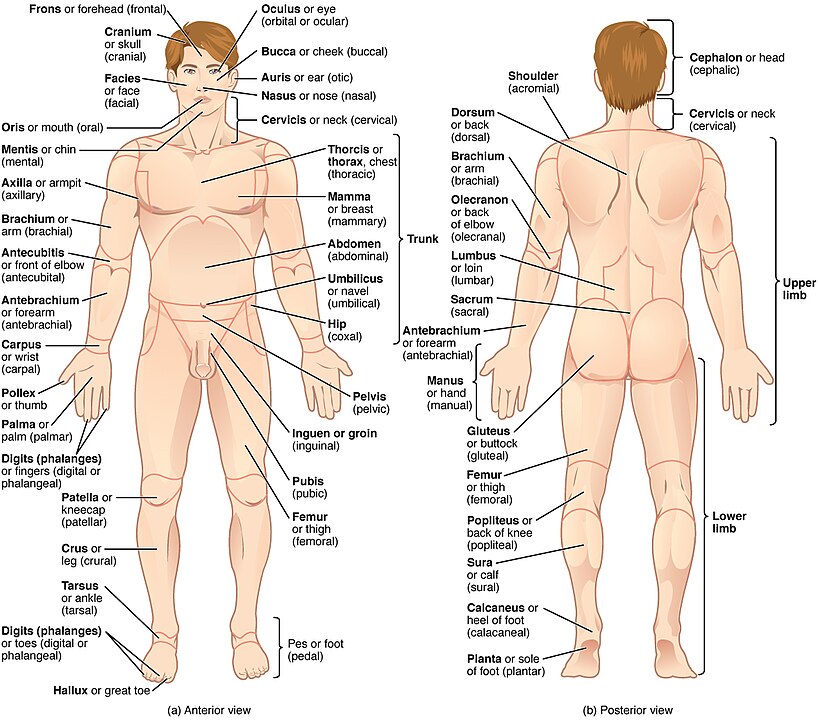
Abdominal Regions
The abdomen can be further divided into four quadrants or nine regions. These are very important in clinical practice.
Four quadrants
Right-lower quadrant
Left-lower quadrant
Nine Regions
Right lumbar
Right iliac
Umbilical
Hypogastric
Left lumbar
Left iliac
These regions are shown in the figure below.

Organs in the Abdominal Regions
Subdivisions of the Abdomen
Right Hypochondriac Region
Digestive:
Liver
Gall Bladder
Small Intestine
Ascending Colon
Transverse Colon
Endocrine:
Right Kidney
Excretory:
Right Kidney
Lymphatic:
NONE
Reproductive:
NONE
Epigastric Region
Digestive:
Esophagus
Stomach
Liver
Pancreas
Small Intestine
Transverse Colon
Endocrine:
Right & Left Adrenal Glands
Pancreas
Right & Left Kidneys
Excretory:
Right & Left Kidneys
Right & Left Ureters
Lymphatic:
Spleen
Reproductive:
NONE
Left Hypochondriac Region
Digestive:
Stomach
Liver (tip)
Pancreas (tail)
Small Intestine
Transverse Colon
Descending Colon
Endocrine:
Pancreas
Left Kidney
Excretory:
Left Kidney
Lymphatic:
Spleen
Reproductive:
NONE
Right Lumbar Region
Digestive:
Liver (tip)
Gall Bladder
Small Intestine
Ascending Colon
Endocrine:
Right Kidney
Excretory:
Right Kidney
Lymphatic:
NONE
Reproductive:
NONE
Right Iliac Region
Digestive:
Small Intestine
Appendix
Cecum & Ascending Colon
Endocrine:
Right Ovary (Females)
Excretory:
NONE
Lymphatic:
NONE
Reproductive:
Female
Right Ovary
Right Fallopian Tube
Male
NONE
Umbilical Region
Digestive:
Stomach
Pancreas
Small Intestine
Transverse Colon
Endocrine:
Pancreas
Right & Left Kidneys
Excretory:
Right & Left Kidneys
Right & Left Ureters
Lymphatic:
Cisterna chyli
Reproductive:
NONE
Hypogastric Region
Digestive:
Small Intestine
Sigmoid Colon
Rectum
Endocrine:
Right & Left Ovaries (Females)
Excretory:
Right & Left Ureters
Urinary Bladder
Lymphatic:
NONE
Reproductive:
Female
Uterus
Right & Left Ovaries
Right & Left Fallopian Tubes
Male
Vas Deferens
Left Lumbar Region
Digestive:
Small Intestine
Descending Colon
Endocrine:
Left Kidney (tip)
Excretory:
Left Kidney (tip)
Lymphatic:
NONE
Reproductive:
NONE
Left Iliac Region
Digestive:
Small Intestine
Descending Colon
Sigmoid Colon
Endocrine:
Left Ovary (Females)
Excretory:
NONE
Lymphatic:
NONE
Reproductive:
Female
Left Ovary
Left Fallopian Tube
Male
NONE
Organ Systems
The human body consists of several organ systems that work together to maintain homeostasis. The study of organ systems is also referred to as Systemic Anatomy.
Even though we will study the 10 major organ systems of the body separately, there is no real separation; they in fact work all together via close connections, interactions, and chemical signals.
In this lab, we will introduce the organ systems and its components:
- The integumentary system – provides a protective covering to the body
- The muscular system – provide movement to the body
- The skeletal system – provides framework for movement and protection of the organs of the body
- The nervous system – allows us to interact and interpret the environment (inside and outside)
- The endocrine system – produce hormones
- The cardiovascular system (circulatory and lymphatic system)
- Circulatory system – to transport substances in the body
- Lymphatic system – cleanses and returns tissue fluid to the circulatory system
- The respiratory system – exchange of oxygen for carbon dioxide
- The digestive system –to provide nutrition (fuel) to the tissues of the body
- The urinary/excretory system – discard body waste products
- The reproductive system – responsible for maintenance of species
The Integumentary System

The integumentary system consists of the covering of the body (the skin), including hair and nails as well as other functionally important structures such as the sweat glands and sebaceous glands. The skin is the largest organ we have, it forms a boundary between our delicate inside and the harsh outside environment. It provides containment, structure, and protection for other organs, but it also serves as a major sensory interface with the outside world.

The Musculoskeletal System
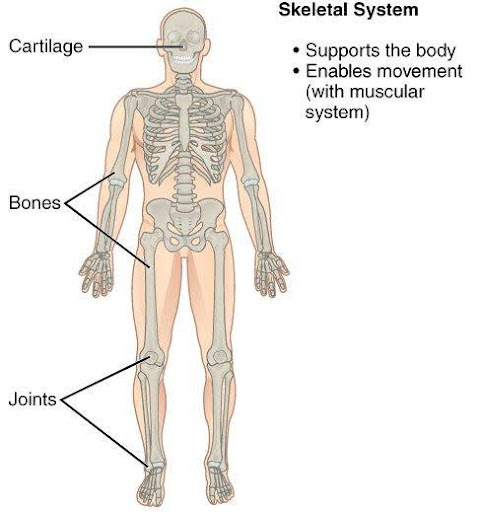
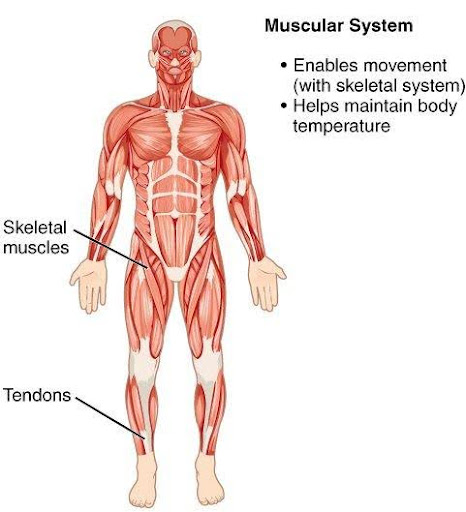
The musculoskeletal system consists of the human skeleton (which includes bones, ligaments, tendons, and cartilage) and attached muscles. It gives the body basic structure, protection to important organs, and the ability for movement. In addition to their structural role, the larger bones in the body contain bone marrow, the site of production of blood cells. Also, all bones are major storage sites for calcium and phosphate. This system can be split up into the muscular system, the skeletal system and joints and articulations.

Video – Joints
Ankle joint
Elbow joint
Video – Muscles
Gluteal Muscles
Erector spinae
The Nervous System

The nervous system consists of the central nervous system (CNS; brain and spinal cord) and the peripheral nervous system (PNS; consist of nerves and ganglia outside the CNS. Includes cranial and peripheral nerves, except cranial nerve II). The brain is the control center of the body. It is the organ of thought, emotion, memory, and sensory processing. It allows for communication and controls of various organ systems in the body. The brain is basically divided in three regions; forebrain, midbrain and hindbrain. The nervous system also includes our special senses; vision, hearing, taste, smell and touch. The eyes, ears, tongue, and nose gather information about the body’s environment.

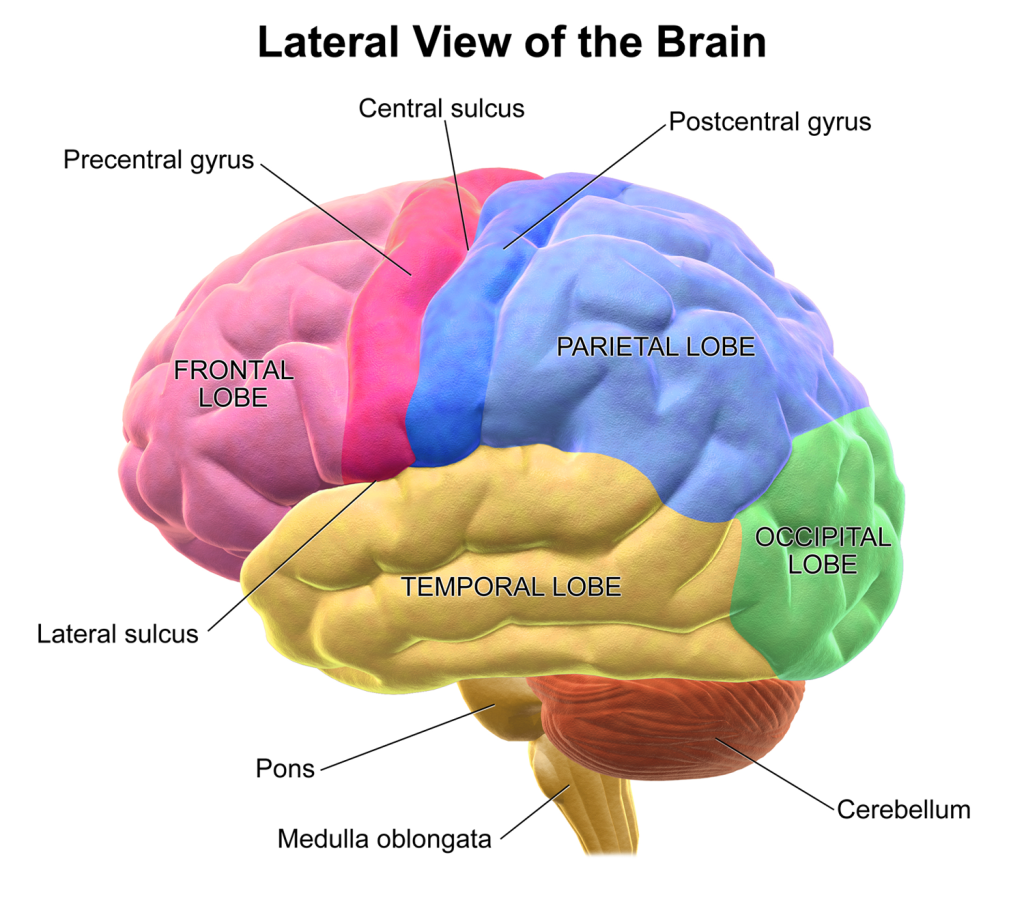
Videos
Hypoglossal nerve
Visual Pathways
Anatomy of the brain – dissectible model
The Endocrine System
The endocrine system consists of the principal endocrine glands: the pituitary (anterior and posterior), thyroid, parathyroid, pancreas, adrenals, and gonads Ovaries and testes), but nearly all organs and tissues produce specific endocrine hormones as well. The endocrine hormones serve as signals from one body system to another regarding an enormous array of conditions and resulting in variety of changes of function. There is also the exocrine system.
The Endocrine System
Cardiovascular System

The cardiovascular system delivers oxygen and nutrients to tissues and equalizes temperature in the body.
Video link – Cardiovascular anatomy introduction

The human circulatory system (simplified). Red indicates oxygenated blood, blue indicates deoxygenated.
Video – Carotid body and carotid sinus anatomy
Lymphatic System

The lymphatic system is part of the circulatory system. It consists of lymphatic organs, lymphatic tissue, lymphatic vessels and lymph. The main function of the lymphatic system is to assist the circulatory system in transporting lymph (the fluid found in between cells Interstitial fluid). The lymphatic organs include the thymus, spleen, lymph nodes, and tonsils. Lymphatic tissue includes Peyer’s patches (small intestine). The lymphatic vessels include right duct, thoracic duct, cisternae chili and lymph vessels. Lymph is very similar to blood plasma, contains white blood cells, waste products, debris of cells, bacteria and proteins.
The Immune System

The immune system consists of the white blood cells, the thymus, lymph nodes and lymph channels, which are also part of the lymphatic system. The immune system provides a mechanism for the body to distinguish its own cells and tissues from alien cells and substances and to neutralize or destroy the latter by using specialized proteins such as antibodies, cytokines, and toll-like receptors, among many others.
The Respiratory System

Respiratory System
- Removes carbon dioxide from the body
- Delivers oxygen to blood
The respiratory system consists of the nostrils, nose, nasal cavity, nasopharynx, trachea, bronchi, bronchioles and lungs. The lungs serve as a site for exchange of gasses, carbon dioxide from metabolic waste from cells with oxygen from the air. The respiratory system also has a minor function as an excretory organ.
The Digestive System

The digestive system processes food for use by the body and removes waste from undigested food.
The digestive system consists of the mouth including the tongue and teeth, esophagus, stomach, gut (gastrointestinal tract (GI), small and large intestines, and rectum). It also has accessory organs such as the liver, gallbladder, pancreas, and salivary glands. It converts the food we ingest into smaller units of nutritional content, to be absorbed by the intestines into circulation for further distribution of fuels for all cells of the body. The circulatory system absorbs what is needed, and excretes the unused residue as feces.
Video – stomach
The Urinary System

The urinary system consists of the kidneys, ureters, urinary bladder, and urethra. It removes metabolic wastes from the blood to produce urine, which carries a variety of waste molecules and excess ions and water out of the body. The kidneys are the major organs of filtration; they consist of millions of functional units called nephrons. The nephrons are composed of the renal corpuscle (glomerulus and Bowman’s capsule) and the tubules (proximal convoluted tubule, loop of Henle, distal convoluted tubule). The collecting ducts collect urine from several nephrons and drain into the minor calices.
Video – Kidney Anatomy
The Reproductive System
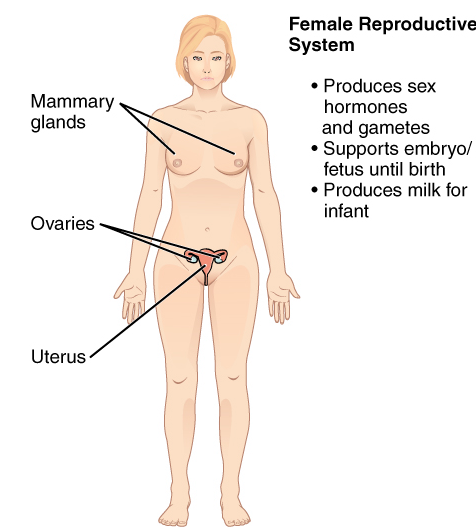

The reproductive system consists of the gonads and the internal and external sex organs. The reproductive system produces gametes in each sex (sperm and oocytes), a site for their combination (fertilization) and formation of the zygote, implantation of the zygote and a nurturing environment for the first 9 months of development of the fetus into an infant.

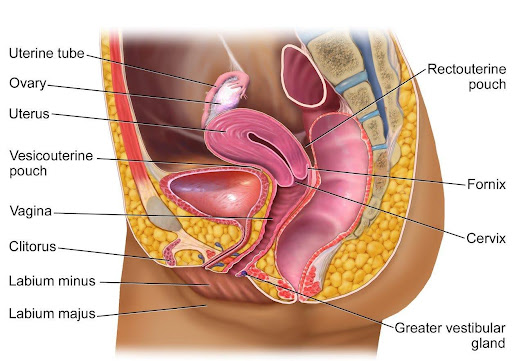
Video – Inguinal Canal
Laboratory Activity
Activity A – Regional Terms
- Use the images of the Mini Muscle Man/Woman (anterior and posterior view) to label the regions shown.
- Find the following locations of the body using the muscle man image (above), then provide the appropriate regional terms on the table shown below
| Common term | Regional Term |
| Elbow | |
| Neck | |
| Kneecap | |
| Armpit | |
| Leg | |
| Hip | |
| Inguinal | |
| Shoulder | |
| Arm | |
| Neck |
Activity B – Relative Positions, Planes and Sections

You will use a green or hard yellow banana, a green onion, a plastic knife and black sharpie.
Procedure
- Review the following terms:
- Longitudinal
- Coronal
- Sagittal
- Parasagittal
- Horizontal
- Transverse
- Do not peel your banana.
- Using the caricature shown here as an example, mark the following regions on your banana peel
- Anterior
- Posterior
- Cephalic (superior)
- Caudal (inferior)
- Right and Left
- Take a picture of your banana to upload on your Learning Management System (LMS).
- Perform the following cuts:

What type of section is this?

What type of section is this?

What type of section is this? - Also perform the following cuts:
- Sagittal
- Coronal
- Transverse
- Parasagittal
- Mention two types of longitudinal cuts:

- Is a transverse cut the same as a horizontal cut? And a cross section (c.s.)?

- Using a green onion, perform a transverse cut, oblique cut and a longitudinal cut.


What do you see, how does this related to a cut through a section of small intestine?

What type of sections is shown here?


Activity C – Identify Planes and Sections
- These are images of the brain. Name the type of section performed in each of the images shown below:
- Brain image #1
- Brain image #2
- Brain image #3

For 100% online courses, skip using the brain images and use the drag and drop activity provided below to complete the labeling activities.
Activity D – Body Cavities
- Name the body cavities shown on these images – use the table provided below.

| Number | Name of Body Cavity |
| 1 | |
| 2a | |
| 2b | |
| 2c | |
| 2d | |
| 3 | |
| 4 | |
| 5 | |
| 6 | |
| 7 |
Activity E – Label the regions of the abdomen
- Label the 4 quadrants of the abdominal area

- Name the organs located in the epigastric region

- Name the organs located in the right iliac region

- Name the organs located in the left lumbar region
Activity 4 – Organ systems
- Label the name of the organ and by the side of the name in parenthesis write the name of the organ system to which that organs belongs to.

- Locate and label the following organs on the torso model’s images shown here in the tables
Organ Organ System Brain Spinal Cord Thyroid gland Adrenal glands Pancreas Ovaries Testis Heart Larynx Lungs Trachea Esophagus Stomach Small intestine Large intestine Vermiform Appendix Rectum Liver Gallbladder Spleen Axillary Lymph nodes Urinary bladder Ureters kidneys Prostate gland Urethra Mammary glands Abdominal Aorta Superior Vena Cava Inferior Vena Cava
- Anatomical Model, Torso – Anterior View
- Anatomical Model, Torso – Posterior View
- Anatomical Model, Torso – Interior View
- Anatomical Model, Torso – Internal organs, detached
- Anatomical Model, Torso – head section, Internal organs
- Anatomical Model, Torso – neck section, Internal organs
- Anatomical Model, Torso – chest section, Internal organs
- Anatomical Model, Torso – Lower abdomen section, Internal organs
- Anatomical Model, Female Reproductive System
- Anatomical Model, Male Urogenital System
- Name the components of the Endocrine system

- Name the components of the male urinary system

Activity 5 – Critical thinking/Apply what you learned today
- Describe using anatomical and directional terms the location of the tattoo shown here


Plastic Anatomy – By Sam Webster
Feel free to review the following short videos and animations to complement your lab:
Thorax organs – plastic anatomy
Blood supply to small intestine
Abdominal organs
Arcuate line
Ureters
Blood supply to the stomach
Hepatic Portal vein
Aorta
Stomach
Gall bladder and biliary tree
Spleen anatomy
Pancreas anatomy
Liver anatomy
Large intestine anatomy
Small intestine anatomy
Inguinal canal
Posterior Abdominal wall
Adrenal glands
Kidney anatomy
Peritoneum in cling film
Vena Cava
The greater omentum
The lesser omentum
Round ligament of liver or ligamentum teres
Vagus nerve anatomy
Cardiovascular anatomy
Duodenum
Abdomen transverse CT imaging anatomy
Heart Anatomy
Female pelvic organs introduction
Organ Systems Worksheets
The Urinary System
- Label the main structures of the Urinary System. After completing this activity, self-assess your answers by comparing with the key provided in the next page.
| Number | Structure | Number | Structure |
| 1 | 8 | ||
| 2 | 9 | ||
| 3 | 10 | ||
| 4 | 11 | ||
| 5 | 12 | ||
| 6 | 13 | ||
| 7 | 14 |
For 100% online courses, skip using the brain images and use the drag and drop activity provided below to complete the labeling activities.
The Skeletal System – Diagrams
Label the main bones of the human body.


The Respiratory System
The human respiratory system is divided into the upper and lower tracts. The upper respiratory tract includes the nose and nasal passages, paranasal sinuses, the pharynx, and the portion of the larynx above the vocal folds (cords). The lower respiratory tract includes the portion of the larynx below the vocal folds, trachea, bronchi, and bronchioles. The lungs are included in the lower respiratory tract.
Activity
- Label the main structures of the Respiratory System. After completing this activity, self-assess your answers by comparing with the key provided in the next page.

| Number | Main structures of the Respiratory system |
| 1 | |
| 2 | |
| 3 | |
| 4 | |
| 5 | |
| 6 |
For 100% online courses, skip using the brain images and use the drag and drop activity provided below to complete the labeling activities.
The Reproductive System
Label the diagrams
- Female – sagittal section of pelvis

| # | Structure |
| 1 | |
| 2 | |
| 3 | |
| 4 | |
| 5 |
- Male – sagittal section of pelvis

| # | Structure |
| 1 | |
| 2 | |
| 3 | |
| 4 | |
| 5 | |
| 6 | |
| 7 | |
| 8 | |
| 9 | |
| 10 | |
| 11 | |
| 12 | |
| 13 |
The Muscular System
Review the main muscles of the human body

File: Muscles anterior labeled.png https://commons.wikimedia.org/wiki/File:Muscles_anterior_labeled.png This work is in the public domain in its country of origin and other countries and areas where the copyright term is the author’s life plus 100 years or fewer.
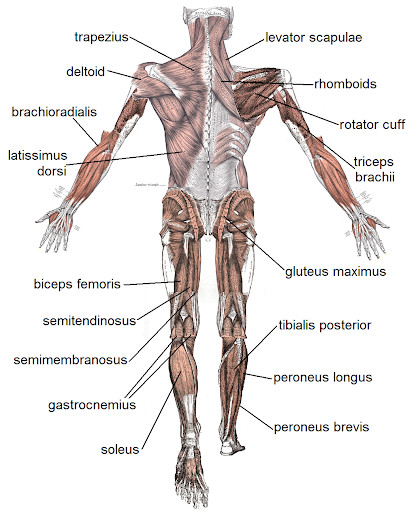
File: Muscle posterior labeled.png https://commons.wikimedia.org/wiki/File:Muscle_posterior_labeled.png This work is in the public domain in its country of origin and other countries and areas where the copyright term is the author’s life plus 100 years or fewer.
The Integumentary System
Label the diagram – components of the integumentary system

Hair
Nail
Skin
Glands in skin
The Endocrine System
- Label the main structures of the Endocrine System. After completing this activity, self-assess your answers by comparing with the key provided in the next page.

| Main structures |
| 1. |
| 2. |
| 3. |
| 4. |
| 5. |
| 6. |
| 7. |
| 8. |
| 9. |
For 100% online courses, skip using the brain images and use the drag and drop activity provided below to complete the labeling activities.
The Digestive System
The gastrointestinal tract, also called the digestive tract, alimentary canal, or gut, is the system of organs within multicellular animals that takes in food, digests it to extract energy and nutrients, and expels the remaining waste.
Label the main structures of the Digestive System. After completing this activity, self-assess your answers by comparing with the key provided in the last page.

| Number | Main structures of the Urinary system |
| 1 | |
| 2 | |
| 3 | |
| 4 | |
| 5 | |
| 6 | |
| 7 | |
| 8 | |
| 9 | |
| 10 | |
| 11 | |
| 12 | |
| 13 | |
| 14 | |
| 15 | |
| 16 | |
| 17 | |
| 18 | |
| 19 | |
| 20 | |
| 21 | |
| 22 | |
| 23 | |
| 24 | |
| 25 | |
| 26 | |
| 27 | |
| 28 | |
| 29 | |
| 30 |
For 100% online courses, skip using the brain images and use the drag and drop activity provided below to complete the labeling activities.

The Nervous System
Label the components of the CNS: Brain and Spinal cord.

The Cardiovascular System
The cardiovascular system includes the heart, blood vessels, and blood which is located inside the blood vessels and circulates throughout the entire body bringing nutrients to all cells and removing their metabolic waste.
Label the main structures of the Cardiovascular System.

| Number | Main structures of the Cardiovascular system |
| 1 | |
| 2 | |
| 3 |
Media Attributions
- Anatomical position © Wikimedia is licensed under a CC BY (Attribution) license
- Directional terms © By OpenStax College. Anatomy & Physiology, Connexions Web site. http://cnx.org/content/col11496/1.6/, Jun 19, 2013. - http://cnx.org, CC BY 3.0, https://commons.wikimedia.org/w/index.php?curid=29624321 is licensed under a CC BY (Attribution) license
- Planes of body © OpenStax College. Anatomy & Physiology, Connexions Web site. http://cnx.org/content/col11496/1.6/ is licensed under a CC BY (Attribution) license
- Body Cavities © Wikipedia is licensed under a CC BY (Attribution) license
- Regions of human body © By Connexions / OpenStax - https://cnx.org/contents/FPtK1zmh@8.25:fEI3C8Ot@10/Preface, CC BY 4.0, https://commons.wikimedia.org/w/index.php?curid=29624317 is licensed under a CC BY (Attribution) license
- Abdominal quadrant regions © By OpenStax. Download for free at http://cnx.org/contents/17e4eea8-a005-45af-b835-f756a014cd48@3., CC BY 3.0, https://commons.wikimedia.org/w/index.php?curid=29624324 is licensed under a CC BY (Attribution) license
- Integumentary system © Wikipedia is licensed under a CC BY (Attribution) license
- Skin © Wikipedia is licensed under a CC BY (Attribution) license
- Skeletal system © Wikipedia is licensed under a CC BY (Attribution) license
- Muscular system © Wikipedia is licensed under a CC BY (Attribution) license
- Human skeleton front © Wikipedia is licensed under a CC BY (Attribution) license
- Anterior muscular system © Wikipedia is licensed under a Public Domain license
- Nervous sytem © Wikipedia is licensed under a CC BY (Attribution) license
- Human brain © Wikipedia is licensed under a CC BY (Attribution) license
- Brain lateral view © Wikipedia is licensed under a CC BY (Attribution) license
- Endocrine © OpenStax & Tomáš Kebert & umimeto.org
- Cardiovascular system © Wikipedia is licensed under a CC BY (Attribution) license
- Heart anterior exterior view © Wikipedia is licensed under a CC BY (Attribution) license
- Diagram of the heart © Wikipedia is licensed under a CC BY (Attribution) license
- Circulatory System © By LadyofHats, Mariana Ruiz Villarreal - Did myself based in the information and diagrams found in:"gray's anatomy" thirty sixth edition by Williams & Warwick."Sobotta Atlas der Anatomie des menschen" volume 1 and 2 18.Auflage by Urban & Schwarzenberg"Atlas fotografico de anatomia del cuerpo humano" 3a edicion by Yokochi, Rohen & Weinrebmultiple websites included:[1], [2], [3], [4], [5], [6], and others., Public Domain, https://commons.wikimedia.org/w/index.php?curid=6698231 is licensed under a CC BY (Attribution) license
- Lymphatic System Female © By BruceBlaus. When using this image in external sources it can be cited as:Blausen.com staff (2014). "Medical gallery of Blausen Medical 2014". WikiJournal of Medicine 1 (2). DOI:10.15347/wjm/2014.010. ISSN 2002-4436. - Own work, CC BY 3.0, https://commons.wikimedia.org/w/index.php?curid=28086436 is licensed under a CC BY-SA (Attribution ShareAlike) license
- White blood cells © By BruceBlaus. When using this image in external sources it can be cited as:Blausen.com staff (2014). "Medical gallery of Blausen Medical 2014". WikiJournal of Medicine 1 (2). DOI:10.15347/wjm/2014.010. ISSN 2002-4436. - Own work, CC BY 3.0, https://commons.wikimedia.org/w/index.php?curid=28223981 is licensed under a CC BY (Attribution) license
- Respiratory system © LibreTexts is licensed under a CC BY-SA (Attribution ShareAlike) license
- Respiratory system complete © By LadyofHats, Jmarchn - Own work using:Sobotta, Johannes (1982) Atlas der Anatomie des Menschen / 2 Brust, Bauch, Becken, untere Extremitäten, Haut. (18th ed.), Munich: Urban & Schwarzenberg ISBN: 3-541-02828-9. OCLC: 260005032.Gray, Henry (1980) Gray's Anatomy (36th ed.), Edinburgh: Churchill Livingstone ISBN: 0-443-01505-8. OCLC: 7775214.Yokochi, Chihiro (1991) Atlas fotográfico de anatomía del cuerpo humano (3rd ed.), Mexico: Interamericana/McGraw-Hill ISBN: 968-25-1677-3. OCLC: 33318149.Also used several online diagrams like:[1][2], Public Domain, https://commons.wikimedia.org/w/index.php?curid=3945169 is licensed under a CC BY (Attribution) license
- Digestive System © LibreTexts is licensed under a CC BY-NC-SA (Attribution NonCommercial ShareAlike) license
- Digestive system diagram © By Mariana Ruiz, Jmarchn - Own work, Public Domain, https://commons.wikimedia.org/w/index.php?curid=2898771 is licensed under a CC BY-SA (Attribution ShareAlike) license
- Renal system © Britannica is licensed under a All Rights Reserved license
- Female Reproductive System © LibreTexts is licensed under a CC BY-NC-SA (Attribution NonCommercial ShareAlike) license
- Male Reproductive System © LibreTexts is licensed under a CC BY-NC-SA (Attribution NonCommercial ShareAlike) license
- Male reproductive anatomy © Wikipedia is licensed under a CC BY-SA (Attribution ShareAlike) license
- Female reproductive anatomy © Wikipedia is licensed under a CC BY-SA (Attribution ShareAlike) license
- Image 6-20-24 at 9.27 AM
- Banana section 1 © drguptabiology.weebly.com is licensed under a CC BY-SA (Attribution ShareAlike) license
- Banana section 2 © drguptabiology.weebly.com is licensed under a CC BY-SA (Attribution ShareAlike) license
- Banana section 3 © drguptabiology.weebly.com is licensed under a CC BY-SA (Attribution ShareAlike) license
- Green onions © Maria Carles is licensed under a CC BY-SA (Attribution ShareAlike) license
- scallion cut 1
- scallion cut 2
- Body Cavities labeled © By OpenStax - https://cnx.org/contents/FPtK1zmh@8.25:fEI3C8Ot@10Version 8.25 from the TextbookOpenStax Anatomy and PhysiologyPublished May 18, 2016, CC BY 3.0, https://commons.wikimedia.org/w/index.php?curid=64287786 is licensed under a CC BY-SA (Attribution ShareAlike) license
- Muscle man to label adapted by 3B Scientific is licensed under a CC BY-SA (Attribution ShareAlike) license
- Muscle man to label abdominal divisions © Maria Carles adapted by 3B Scientific is licensed under a CC BY-SA (Attribution ShareAlike) license
- Endocrine system © Wikipedia is licensed under a CC BY (Attribution) license
- Male Urinary System label
- Tree tatoo © Maria Carles adapted by Foursquare is licensed under a CC BY-SA (Attribution ShareAlike) license
- Urinary system © Wikipedia is licensed under a CC BY-SA (Attribution ShareAlike) license
- Private: Human skeleton front Label © Wikipedia adapted by Maria Carles is licensed under a CC BY-SA (Attribution ShareAlike) license
- Private: Human skeleton back Label © Wikipedia adapted by Maria Carles is licensed under a CC BY-SA (Attribution ShareAlike) license
- Private: Respiratory tract Label © Wkipedia adapted by Maria Carles is licensed under a Public Domain license
- Private: Female – sagittal section of pelvis © Wikipedia adapted by Maria Carles is licensed under a CC BY-SA (Attribution ShareAlike) license
- Private: Male – sagittal section of pelvis © Wikipedia adapted by Maria Carles is licensed under a CC BY-SA (Attribution ShareAlike) license
- Private: Posterior muscular system © Wikipedia is licensed under a Public Domain license
- Private: Integumentary system © Maria Carles is licensed under a CC BY-SA (Attribution ShareAlike) license
- Private: Endocrine System label © OpenStax adapted by Maria Carles is licensed under a CC BY-SA (Attribution ShareAlike) license
- Private: Digestive system diagram numbered © Wikipedia is licensed under a CC BY-SA (Attribution ShareAlike) license
- Private: Central nervous system © Wikipedia is licensed under a CC BY-SA (Attribution ShareAlike) license
- Private: Vein art near © Wikipedia is licensed under a CC BY-SA (Attribution ShareAlike) license










